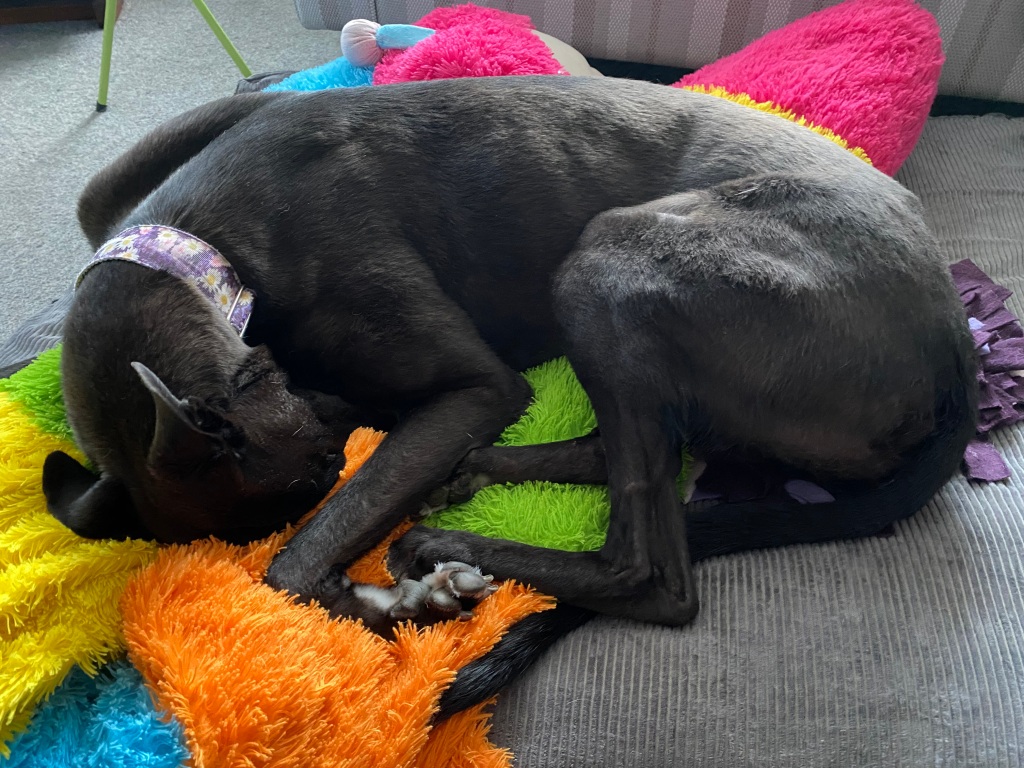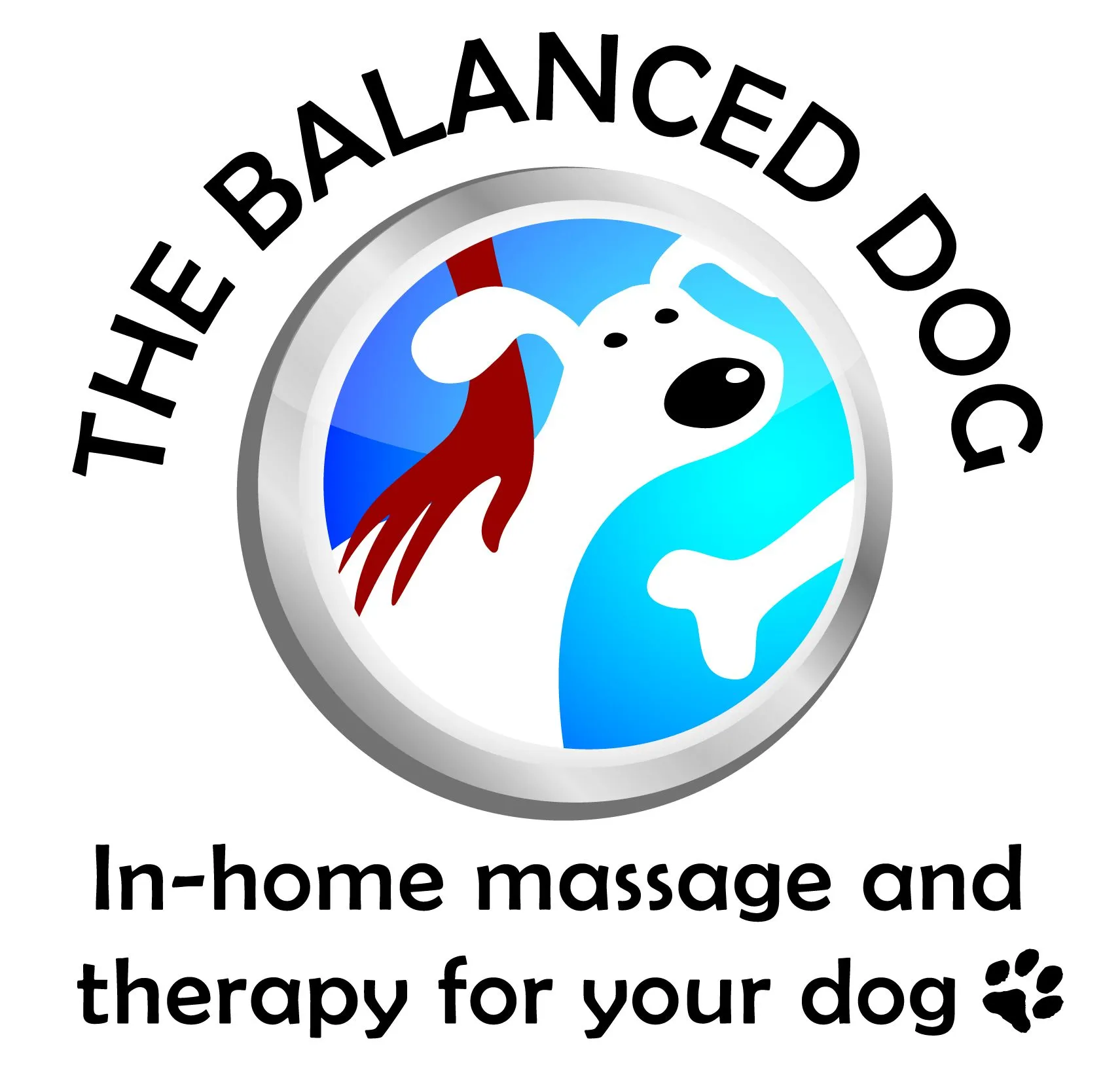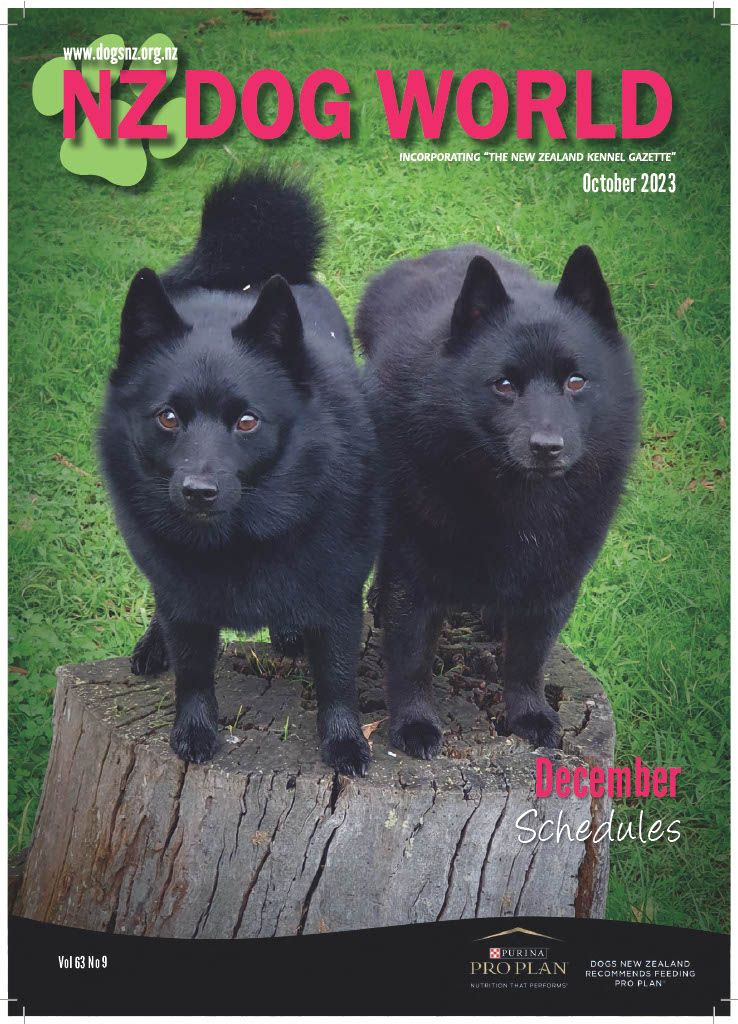Rosie is my foster dog; she arrived one month ago exactly, on 17 December 2021.
Rosie is an affectionate black greyhound who has had three unsuccessful adoption placements. You see, Rosie is profoundly deaf.
She was not born deaf, but she became deaf through ear infections – and what appears to be lots of them, or at least ones that had unsuccessful or no treatment. Her ear canals are so severely scarred that about the only sound she has reacted to was the high-pitched loud squeal of my burglar alarm which I set off accidentally last month.
But there is a lot more you need to know about Rosie to understand her
Rosie doesn’t know she is special needs. She simply lives in a world where she sees people’s lips move but no sound comes out. She is reluctant to make eye contact with new people and so can easily misread their intentions. She responds to emotional energy very well; she seems to know when someone is smiling and wants to give her a pat; I always ask them to allow her to come to them which works well.
When Izzy died, she certainly knew I was upset and came in for lots of cuddles and reassurance.
She isn’t so sure of people wearing masks because masks cover faces and Rosie needs faces to read the situation. I have been deliberately taking her places where she meets people in masks and where I am wearing mine. She even came with me to the drive-thru vaccination clinic when it was time for me to have my Covid-19 booster shot; she barked anxiously at the face outside the window.
Mask-wearing will be part of our lives for a while and Rosie needs to live successfully in a masked up world so I will continue exposing her in a controlled manner to mask-wearing people so she can become more confident. Today, for example, we went to the local SPCA op shop which welcomes pets. The shop attendants and the customers were all wearing masks. We didn’t have any issues.
Rosie has lots of energy. When the sun is up, so is she. Forget the advice that a greyhound is so placid that two, 20-minute walks per day are sufficient exercise. Rosie has been having two walks of at least 30-40 minutes each and cracks a good pace for the entire time. An hour’s long walk on the beach with greyhound Misty was not problem for her, either.
I gave Rosie a massage over the weekend (her first) and I can assure you that she has great muscle tone. For a girl who is now 6 years, 9 months old, she is in great shape!
Rosie would benefit from being adopted by a household with another dog who is well-settled and playful. Rosie likes to play (she has had several play dates and is enthusiastic about engaging with other dogs who are both off-lead and on-lead). A dog that could be Rosie’s mentor will give her someone to follow around and mimic. In my opinion, a chilled out dog who can teach Rosie the house rules will see her settle into a new adoptive home pretty quickly.
Remember, though, that Rosie is deaf. She will always be deaf no matter how much training she receives. Rosie misses out on the low growls of dogs who are giving her a warning signal.
She doesn’t hear the children on the footpath who are coming from behind on scooters (startling her in the process). Whomever adopts Rosie needs to understand that they need to be her ears when they are out of the house – at all times. And when integrating into her new home, the dog:dog interactions will need to be supervised initially. Rosie doesn’t mean to be annoying, but she could be, in her enthusiasm to play.
Every greyhound needs a securely fenced section.
Rosie definitely needs one and always will. Off-lead exercise can only happen in securely fenced areas.

You may have heard that people who lose the their hearing seem to develop enhanced senses of touch, taste, smell, and sight. This is definitely the case with Rosie.
She is a sighthound. I can attest to the fact that Rosie triggers on all movement. So that is definitely cats, ducks, chickens, other birds, and rabbits. She also reacts to leaves, branches, pieces of rubbish and even my neighbour’s clothes on the line when they move in the breeze. Last week we were taking an afternoon walk along Papanui Road and the sunlight was reflecting off cars onto the ceiling of the shop walkway. Rosie startled at the reflections because it looked like something overhead was coming our way.
Consequently, it’s essential that anyone who walks Rosie does so with a firm grip of the leash and with it wrapped around their wrist. Always. And so that means that Rosie cannot be taken on walks by young members of an adoptive family. Adults only. Able-bodied ones, too. And please – a normal leash and not those horrible extension leads…

If Rosie sees something of interest – like a neighbourhood cat – she will pull and rear up on her hind legs. Hold your ground and hold on tight. Rosie should always be walked in a harness for greater control and to avoid damage to her neck.
Rosie is a deep sleeper. All greyhounds sleep. Rosie sleeps more deeply than most. We know that dogs have a different sleep pattern than we do, but since Rosie cannot hear, it seems that she goes into a deep REM-like sleep more often. (This explains her energy levels when she’s awake – refreshed and ready to go!)

Greyhounds are known for their sleep startle – that sweet little greyhound can become a raving Cujo when wakened suddenly. In Rosie’s case, her risk of sleep startle is much greater. Therefore, I have developed a new habit of walking into a room with a good solid stomp of my foot. The vibrations will stir Rosie from her slumber.
The risk of sleep startle is another reason why Rosie cannot go to a home with small children, who are unlikely to remember the rules about engaging with a sleeping Rosie. Mature households only are needed as Rosie’s eventual adoptive family to keep everyone safe.
I mentioned earlier that Rosie is cuddly and affectionate. I have allowed her to sleep on my bed, particularly because she really wanted to snuggle and because she came one night to my bedroom at about 3 am when I was simply too tired to keep pushing her off the bed. Besides, I feel that since she has shown no interest in the sofa, she rightly deserves a chance to be a real pet greyhound and sleep on the bed.
Rosie is completely house-trained and she only barks when she is excited (such as when I am taking too much time to get dressed in the morning for our walk). I have had a pet cam running constantly for the last three weeks – she only whimpers a bit when I leave the house and then eventually settles on her bed for a deep sleep. She will sometimes go into the crate for a rest, but the crate is also strategically positioned so she can watch me in the kitchen from a safe distance.
In the interest of finding Rosie her forever home, I have begun working with Rosie on an essential cue – Look At Me. The Look At Me is the foundation for interacting with her handler so that she can then react to other visual cues which will be trained over time. I have already instituted her Come command, which is a vigourous tapping of my thigh.
We are perfecting her Look At Me and Come. Good things take time and I keep her training sessions short – only about 5-10 minutes each maximum. This ensures Rosie is set up for success. I am thoroughly happy to keep Rosie for as long as it takes until we find her the perfect match for her adoptive home and, in the meantime, we can continue our training and enjoy each other’s company.
Enquiries about adopting Rosie should be directed to Greyhounds as Pets.
Kathleen Crisley, Fear-Free certified professional and specialist in dog massage, rehabilitation and nutrition/food therapy, The Balanced Dog, Christchurch, New Zealand













